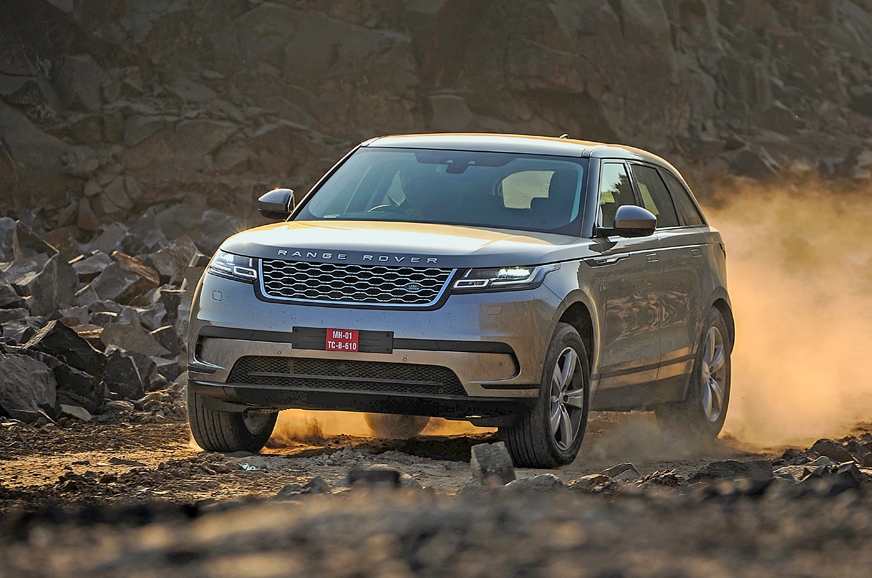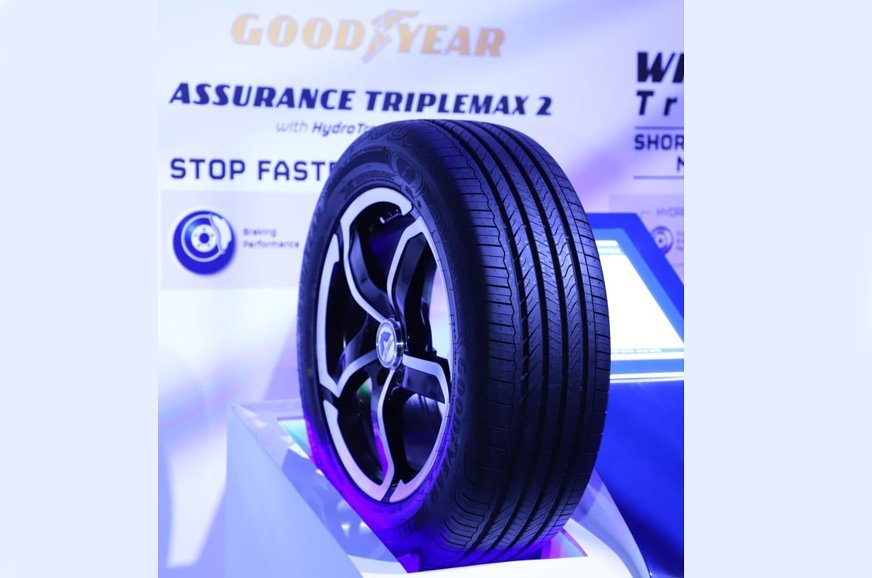
What is it?
The Velar is the fourth model in Range Rover’s ever-expanding line-up; one that sits between the Evoque and Range Rover Sport in terms of size and price. Like the F-Pace, its cousin from Jaguar, the Velar uses aluminium-intensive construction and shares the same wheelbase, too. But before all else, it is (in my view) the world’s sexiest SUV. Go on – see the images and all sides of the new Rangie. I think you’ll agree – the Velar just does not have a single bad angle.
The relatively low silhouette courtesy the form-fitting roof, the prominent ridge around the glasshouse and the huge wheel arches are integral to the 4.8-metre long Velar’s visual appeal. Study its tight-skinned body in detail and you won’t find any superfluous details either. Range Rover’s designers call their approach towards the SUV’s styling ‘reductionism’ – anything that need not be there is not there. As is evident, the lines are crisp, attention to detail is impeccable and, heck, even the door handles got their fair share of attention at the design stage. They sit flush with the body and only pop out when the car is unlocked. You won’t look at car door handles the same way after you see the Velar’s in action.
Note, our test car is in mid-spec SE trim. We’d spec the Velar with the optional ‘Black Pack’ that has the roof, grille, wing mirrors and other bits finished in the colour. And of course, we’d spend on the optional black rims; the stock ones are a bit boring. See a Velar in the right colour combo and you’ll know what we mean. This is one of those models that lends itself well to being ‘murdered out’.

What’s it like on the inside?
If for whatever reason the Velar’s design hasn’t won you over, its cabin surely will. Take as much as a peek inside and you’ll realise how much of a step forward Range Rover has taken with the Velar. Not to say Range Rover has a reputation for dull interiors; far from it in fact. It’s just that the Velar’s cabin incorporates technology in a Rangie like never before, and in the bargain makes the interior look and feel cutting edge. The talking point, of course, is what Land Rover calls Touch Pro Duo, its latest infotainment system. The interface comprises not one but two high- definition 10-inch touchscreens stacked on the centre console. The unit on top is electrically adjustable for angle and is meant to control or access routine functions like navigation, phone or audio, while the lower one is your go-to panel for less frequently altered settings such as those for climate control and drive modes. The lower screen’s resolution is good enough to watch a movie on (thankfully, that’s not possible), and the graphics to represent drive modes are just plain brilliant. Sure, the two-screen arrangement may sound a bit convoluted and unnecessary even, but spend a day with the Velar and you’ll make sense of the controls. However, the lower screen does require you to take your eyes off the road once in a while to access the function you want to operate, but selections thereafter can be made via the physical control knobs. In total, there are just three control knobs (of which one is for volume control) on the entire centre console. Did someone say something about reductionism?
And the tech fest doesn’t end there. There’s a high-res digital instrument cluster and even the steering buttons have touch-sensitive surfaces. It’s quite cool to whirl your thumb on the button to adjust volume, just like on the earlier-generation iPods. And head-up display is an option too. But for all the gizmos the Velar offers, it’s a shame that modern-day essentials of Apple CarPlay and Android Auto have been given a miss. As for the rest of the cabin, it’s really well finished and has that typical look and feel of robustness of Land Rover family interiors. The dashboard is neat, there are a reasonable number of storage spaces and enough charging sockets to keep each of the passenger’s mobile devices juiced up.
The Velar may not be a particularly tall SUV but you sit at a good height and drivers will like the view out. Those seated at the back, however, might find the Velar doesn’t quite give the panoramic view you’d expect from an SUV – blame the relatively small windows. Still, our test car’s optional full-length glass roof did make the rear section feel really airy. Access to the rear seat is a bit tricky because of the high door sill and the middle passenger will feel like an unwanted guest too. But as a space for two, there’s a good deal of legroom on offer, the seat is supportive (some of us did find the lumbar support in excess) and the backrest can handily be reclined electrically.

Boot space isn’t the best for an SUV of this size but the Velar does offer the flexibility of split-folding rear seats. What is commendable is that the Rangie comes with a full-size spare tyre as standard.
What’s it like to drive?
The Velar is offered in India with three engine options – a 180hp, 2.0-litre diesel, a 300hp, 3.0 V6 diesel and a 250hp, 2.0 petrol. The last one is of particular interest because it’s an all-new engine from Jaguar Land Rover’s Ingenium family, and one that will make its way onto other JLR cars in India in the near future too. The Velar happens to be the launch vehicle for the new engine in India and the engine in question is the one powering our test car.
One of the highlights of this engine is how refined it is. It takes a moment to settle down upon starting up, but the sound from under the bonnet fades into the ambient noise quickly. Even on the go, it runs quite muted, and, in effect, masks the performance it has to offer. The build-up of speed is strong and linear, right up to the 6,500rpm limiter, and often the engine feels larger than a humdrum 2.0-litre unit. Responses to changes in throttle position are quick, making overtaking traffic almost a non-event. On occasion, though, the eight-speed gearbox does get a bit jerky in its shifts. There is always the option to take manual control and shift gears via the paddles.
As quick as the Velar feels, it doesn’t quite set the benchmark for performance. A Porsche Macan with a 252hp, 2.0-litre petrol engine is quicker in flat-out and kickdown acceleration. The Velar’s portly 1.9-tonne mass could be to blame, here.
The Velar uses an all-independent suspension setup with double wishbone up front and a multi-link arrangement at the rear. However, not all Velars are built the same. Only V6 diesels get air suspension, while others, like our test P250 version, use steel springs. Ride quality from the standard setup is good but not as great as that of the larger Range Rovers, for which they are famous. There’s pronounced side-to-side movement on broken surfaces at low speeds, expansion joints and the like can be felt in the cabin, and there is a slight wavy motion at cruising speeds too. Switching to ‘Dynamic’ does arrest some of the unwanted movement but there’s no getting around the firmness at low speeds. Still, the 19-inch tyres make light work of potholes, and there’s enough space to the ground to clear the largest of speedbreakers. Also, the Velar is Mumbai monsoon-ready with a wading depth of 600mm.

The Velar may seem made for the high-fashion streets of Madrid, but as a Range Rover, it had better perform in the mud too. The good news is, it does. The Velar comes with a rear-biased all-wheel-drive system as standard, and there’s Land Rover’s Terrain Response system thrown in for good measure as well. It all does come together well. The electronics suite that includes hill descent control keeps things tidy in the rough, and you won’t find the tyres scrabbling for grip at any point either. There’s no low range on any version of the Velar, but then again, if you want a more hardcore off-roader, Land Rover would be happy to point you in the direction of the Discovery that is available for similar money.
And last but not least, handling. Range Rover calls the Velar its most road-biased SUV yet, and there is truth to the statement. As Rangies go, the Velar feels fairly happy to change direction and it offers good grip. But as SUVs in general go, it is not quite at the pointy end of the handling pyramid. The Velar doesn’t feel as sharp as the Macan or even the F-Pace for that matter, and you can feel its heft in the corners. The steering too feels a bit artificially weighted in Comfort mode, but switch to ‘Dynamic’ and it becomes far more natural in feel and weight.
Should you buy one?
To someone sold on the Velar’s looks, and with pockets deep enough to stomach its hefty Rs 80 lakh-plus price, this review should serve as the final nudge to sign that cheque. Others, still in two minds about if this is the SUV to buy for the money, should know the Velar is about so much more than just its designer looks. For one, it’s got a high-tech cabin that all of a sudden makes other luxury SUVs feel a generation old. The requirements of comfort, refinement and performance are well catered to as well, and though there are more exciting driver’s SUVs, you won’t do too bad in a Velar either. It’s quite pricey even by luxury SUV standards, but what’s a few lakhs here and there to have one of the new stars of the auto world in your driveway?












